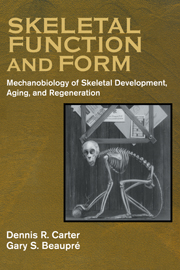Book contents
- Frontmatter
- Contents
- Preface
- Chapter 1 Form and Function
- Chapter 2 Skeletal Tissue Histomorphology and Mechanics
- Chapter 3 Cartilage Differentiation and Growth
- Chapter 4 Perichondral and Periosteal Ossification
- Chapter 5 Endochondral Growth and Ossification
- Chapter 6 Cancellous Bone
- Chapter 7 Skeletal Tissue Regeneration
- Chapter 8 Articular Cartilage Development and Destruction
- Chapter 9 Mechanobiology in Skeletal Evolution
- Chapter 10 The Physical Nature of Living Things
- Appendix A Material Characteristics
- Appendix B Structural Characteristics
- Appendix C Failure Characteristics
- Index
Chapter 2 - Skeletal Tissue Histomorphology and Mechanics
Published online by Cambridge University Press: 11 January 2010
- Frontmatter
- Contents
- Preface
- Chapter 1 Form and Function
- Chapter 2 Skeletal Tissue Histomorphology and Mechanics
- Chapter 3 Cartilage Differentiation and Growth
- Chapter 4 Perichondral and Periosteal Ossification
- Chapter 5 Endochondral Growth and Ossification
- Chapter 6 Cancellous Bone
- Chapter 7 Skeletal Tissue Regeneration
- Chapter 8 Articular Cartilage Development and Destruction
- Chapter 9 Mechanobiology in Skeletal Evolution
- Chapter 10 The Physical Nature of Living Things
- Appendix A Material Characteristics
- Appendix B Structural Characteristics
- Appendix C Failure Characteristics
- Index
Summary
Cartilage
Cartilage is a phylogenetically primitive tissue and predates bone as the primary connective tissue of the skeleton. Cartilage appeared in the vertebral endoskeleton over 500 million years ago and may have an invertebrate origin (Moss and Moss- Salentijn, 1983). In the adult human, cartilage is present at the articulations between bones and is also found in the walls of the thorax, larynx, trachea, bronchi, nose, ears, and base of the skull (Moss and Moss-Salentijn, 1983). Like bone, cartilage consists of living cells that are embedded in fibrous extracellular matrix. However, cartilage is quite different from bone in its structure, chemical composition, vascularity, metabolism, growth and regeneration processes, and mechanical properties.
Young cartilage cells are called chondroblasts. They are relatively small cells that are often flat, and they are derived from mesenchymal stem cells. Mature cartilage cells, called chondrocytes, are larger, generally round in shape, and surrounded by an abundant extracellular matrix. Cartilage cells are characterized by their production of the extracellular structural protein, type II collagen. By way of contrast, bone, tendon, ligament, and skin cells produce predominantly type I collagen.
Cartilage grows by both interstitial and appositional mechanisms. Interstitial growth occurs by cell division, cell hypertrophy, and an increased production of extracellular matrix molecules. In addition, a chondrogenic fibrous sheath called the perichondrium envelops some regions of cartilage in the developing skeleton. Stem cells within this sheath can differentiate into chondroblasts that produce extracellular molecules that expand the size of the adjacent cartilage mass via an appositional mechanism. The young cartilage cells are then incorporated into the matrix as chondrocytes and can participate in further interstitial growth.
- Type
- Chapter
- Information
- Skeletal Function and FormMechanobiology of Skeletal Development, Aging, and Regeneration, pp. 31 - 52Publisher: Cambridge University PressPrint publication year: 2000



